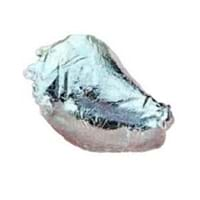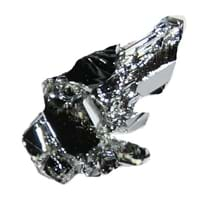Technetium Ruthenium Comparison
Periodic Table
Symbol
Tc
Ru
Group Number
7
11
8
10
Period Number
5
5
Block
d block
d block
Element Family
Transition Metal
Transition Metal
CAS Number
7440268
99+
7440188
99+
Space Group Name
P63/mmc
P63/mmc
Space Group Number
194.00
5
194.00
5
Facts
Interesting Facts
- Original name of Technetium was Masurium.
- At the time of its discovery it found in sample of Molybdenum.
- Ruthenium element has been extracted from used nuclear fuel.
- Ruthenium metal also produces as a by-product of the Nickel mining.
Sources
Made by Bombarding Molybdenum with Deuterons
By-product of Nickel Refining, Found in Minerals, Mining
History
Who Discovered
Emilio Segrè and Carlo Perriero
Karl Ernst Claus
Discovery
In 1937
In 1844
Abundance
Abundance In Universe
Not Available
4 * 10-7 %
20
Abundance In Sun
~-9999 %
~0.0000005 %
22
Abundance In Meteorites
Not Available
0.00 %
26
Abundance In Earth's Crust
Not Available
0.00 %
99+
Abundance In Oceans
Not Available
0.00 %
38
Uses
Uses & Benefits
- Technetium is a radioactive metal and hence it is used for medical studies and other research purposes.
- It is used for producing chip resistors and contact.
- Ruthenium oxide is used to coat the anodes cells for chlorine production in chemical industry. It also works as catalysts for ammonia and acetic acid reaction.
Industrial Uses
NA
Aerospace Industry, Automobile Industry, Chemical Industry, Electrical Industry, Electronic Industry
Medical Uses
NA
Medical Research
Other Uses
Alloys, Nuclear Research, Research Purposes
Alloys
Biological Properties
Toxicity
Low Toxic
Low Toxic
Present in Human Body
No
No
In Blood
0.00 Blood/mg dm-3
37
Not Available
In Bone
0.00 p.p.m.
36
Not Available
Physical Properties
Melting Point
2,200.00 °C
9
2,250.00 °C
8
Boiling Point
4,877.00 °C
7
3,900.00 °C
14
Appearance
Physical State
Solid
Solid
Color
Shiny Gray
Silvery White
Luster
NA
Metallic
Hardness
Mohs Hardness
Not Available
6.50
5
Brinell Hardness
Not Available
2,160.00 MPa
3
Speed of Sound
16,200.00 m/s
1
5,970.00 m/s
4
Optical Properties
Allotropes
No
No
α Allotropes
Not Available
Not Available
β Allotropes
Not Available
Not Available
γ Allotropes
Not Available
Not Available
Chemical Properties
Chemical Formula
Tc
Ru
Isotopes
Known Isotopes
18
21
26
13
Electronegativity
Pauling Electronegativity
1.90
11
2.20
4
Allred Rochow Electronegativity
1.36
20
1.42
18
Allen Electronegativity
1.51
28
1.54
25
Electropositivity
Pauling Electropositivity
2.10
99+
1.80
99+
Ionization Energies
1st Energy Level
702.00 kJ/mol
36
710.20 kJ/mol
32
2nd Energy Level
1,470.00 kJ/mol
99+
710.22 kJ/mol
99+
3rd Energy Level
2,850.00 kJ/mol
33
2,747.00 kJ/mol
37
Electrochemical Equivalent
0.52 g/amp-hr
99+
1.26 g/amp-hr
99+
Electron Work Function
Not Available
4.71 eV
9
Other Chemical Properties
Anti Corrosion, Ionization, Radioactive Isotopes, Radioactivity, Solubility
Anti Corrosion, Ionization, Radioactive Isotopes, Solubility
Atomic Properties
Atomic Number
43
99+
44
99+
Electron Configuration
[Kr] 4d5 5s2
[Kr] 4d7 5s1
Crystal Structure
Hexagonal Close Packed (HCP)
Hexagonal Close Packed (HCP)
Crystal Lattice
HCP-Crystal-Structure-of-Technetium.jpg#100
rystal-Structure-of-Ruthenium.jpg#100
Atom
Number of Protons
43
99+
44
99+
Number of Neutrons
55
99+
57
99+
Number of Electrons
43
99+
44
99+
Radius of an Atom
Atomic Radius
136.00 pm
99+
134.00 pm
99+
Covalent Radius
147.00 pm
37
146.00 pm
38
Van der Waals Radius
200.00 pm
28
200.00 pm
28
Atomic Weight
98.00 amu
99+
101.07 amu
99+
Atomic Volume
8.50 cm3/mol
99+
8.30 cm3/mol
99+
Adjacent Atomic Numbers
Valence Electron Potential
180.00 (-eV)
3
64.00 (-eV)
22
Lattice Constant
273.50 pm
99+
270.59 pm
99+
Lattice Angles
π/2, π/2, 2 π/3
π/2, π/2, 2 π/3
Lattice C/A Ratio
1.60
5
1.58
11
Mechanical Properties
Density
Density At Room Temperature
11.00 g/cm3
34
12.45 g/cm3
27
Density When Liquid (at m.p.)
Not Available
10.65 g/cm3
16
Tensile Strength
Not Available
Not Available
Viscosity
Not Available
Not Available
Vapor Pressure
Vapor Pressure at 2000 K
Not Available
0.00 (Pa)
23
Elasticity properties
Shear Modulus
Not Available
173.00 GPa
4
Bulk Modulus
Not Available
220.00 GPa
7
Young's Modulus
Not Available
447.00 GPa
3
Poisson Ratio
Not Available
0.30
14
Other Mechanical Properties
NA
Ductile, Malleable
Magnetic Properties
Magnetic Characteristics
Specific Gravity
11.50
24
12.45
19
Magnetic Ordering
Paramagnetic
Paramagnetic
Electrical Properties
Electrical Property
Conductor
Conductor
Resistivity
200.00 nΩ·m
18
71.00 nΩ·m
38
Electrical Conductivity
0.07 106/cm Ω
30
0.14 106/cm Ω
16
Electron Affinity
53.00 kJ/mol
18
101.30 kJ/mol
10
Thermal Properties
Specific Heat
0.21 J/(kg K)
29
0.24 J/(kg K)
24
Molar Heat Capacity
24.27 J/mol·K
99+
24.06 J/mol·K
99+
Thermal Conductivity
50.60 W/m·K
30
117.00 W/m·K
13
Critical Temperature
Not Available
Not Available
Thermal Expansion
7.10 µm/(m·K)
99+
6.40 µm/(m·K)
99+
Enthalpy
Enthalpy of Vaporization
660.00 kJ/mol
6
567.80 kJ/mol
10
Enthalpy of Fusion
23.01 kJ/mol
9
25.50 kJ/mol
7
Enthalpy of Atomization
649.00 kJ/mol
8
603.00 kJ/mol
9
Standard Molar Entropy
181.10 J/mol.K
2
28.50 J/mol.K
99+
|
||
|
||
|












